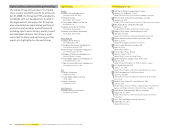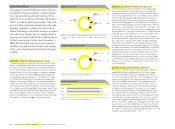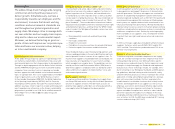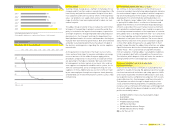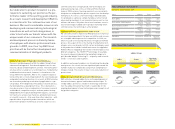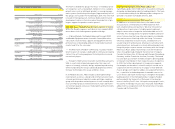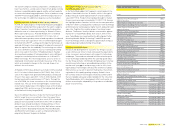Reebok 2008 Annual Report Download - page 72
Download and view the complete annual report
Please find page 72 of the 2008 Reebok annual report below. You can navigate through the pages in the report by either clicking on the pages listed below, or by using the keyword search tool below to find specific information within the annual report.
068 Group Management Report – Our Group Corporate Functions — Sustainability
Monitoring through factory inspections
The SEA team assesses compliance with our Workplace
Standards by means of factory inspections. We apply innovative
monitoring approaches such as deeper and more frequent
monitoring of fewer suppliers in our core supply chain than in
previous years. This allows us to rigorously assess compliance
risks and to identify the root causes of non- compliance. Our
auditors check performance against a customised risk list for
each factory that is monitored. The methodology is linked to
a factory rating which measures the effectiveness of com-
pliance systems and the work of their administrators. This
enables us to precisely determine training needs at our sup-
pliers’ factories. During 2008, we conducted 1,323 factory
visits (2007: 1,007 visits) involving management and worker
interviews, document review, facility inspections and training
sessions at different levels in our supply chain. In addition to
our own monitoring activities, we value independent assess-
ment by third parties to demonstrate the credibility of and
provide verifi ed information about our programme to stake-
holders. As a member of the Fair Labor Association (FLA), the
adidas Group is subject to external assessment by independent
monitors, participation in the FLA third-party complaint system
and public reporting. In 2007, the adidas Group assumed a role
as one FLA participating company as a combined entity (includ-
ing Reebok). In 2008, the consolidated monitoring programme
of the adidas Group was again accredited by the FLA for a
period of two years. This review was based on independent
factory monitoring and verifi cation reports of supplier facili-
ties, and a thorough audit of monitoring protocols, training
programmes and auditing systems. Since joining the FLA,
more than 220 Independent External Monitoring (IEM) audits
and verifi cation visits have been conducted at adidas Group
suppliers.
Warning-letter system to enforce standards
We strongly believe in a partnership approach. Where a sup-
plier is performing poorly in terms of Workplace Standards
compliance, we will work closely with them to fi nd solutions.
However, when we fi nd ongoing and serious instances of non-
compliance and a lack of commitment from factory manage-
ment to address the issues, we send out a formal warning
letter including a notifi cation to factory management that their
business relationship with the adidas Group is in jeopardy. For
threshold compliance issues, three warning letters will usually
result in an immediate recommendation to terminate. We see
termination of business relationships as a last resort. When-
ever possible, we prefer to stay in partnership and work from
the inside to help encourage factory improvements. In 2008,
we terminated our business relationship with two suppliers for
compliance reasons (2007: 4).
System-based approach to managing environmental impacts
We have adopted a system-based approach to managing
environmental impacts in our own production facilities and
throughout our supply chain. Activities focus on helping sup-
pliers establish sound environmental management systems to
best reduce their negative environmental impacts. We develop
guidelines and training programmes for our suppliers, using
the environmental performance of our own production sites as
examples of best practice. We have mandated the implementa-
tion of environmental management systems at our core suppli-
ers to ensure continuous monitoring and improvements. In our
product creation process, we focus on improving materials in
our products and on tackling pollution in factories. Our goal is
to eliminate polluting materials and processes and to increas-
ingly utilise sustainable materials instead.
Control and monitoring of restricted substances
Restricted substances are those that cause harm or are sus-
pected to cause harm to human health or the environment. Our
suppliers are required to avoid using restricted substances. We
have specifi ed clear standards that follow the strictest local
regulations and best practice standards for consumer care
and safety in the Group’s policy for monitoring and control of
hazardous substances. This policy is mandatory for all busi-
ness partners and is updated regularly based on fi ndings in our
ongoing dialogue with scientifi c organisations. Our standards
cover the general requirements for eco-labels and green seals
(e.g. ÖKO-Tex Standard 100, Tox Proof TÜV Rhineland, etc.) for
footwear, apparel and hardware products. Both our own quality
assurance laboratories and external testing institutes are used
to constantly monitor material samples to ensure supplier
compliance with these requirements. Materials that do not
meet our standards and specifi cations are rejected.
Reducing VOC emissions
Volatile Organic Compounds (VOCs), which are typically found
in solvents used in our manufacturing process, can cause
breathing diffi culties and other health problems for production
workers. Therefore, we are committed to reducing VOC emis-
sions in our suppliers’ footwear factories to an average VOC
emission of 20 grams per pair of shoes. Our efforts focus on
nearly all new adidas Group footwear factories and refl ect the
technical synergies of sharing information, data and sources
on production questions such as water-based cement systems.
At our core footwear suppliers we measure exposure to such
emissions, and the records taken provide evidence that work-
ers are not being exposed to dangerous levels of VOCs. Our
athletic footwear suppliers in Asia and Europe have reduced
VOC emissions from 130 grams per pair in 1999 to 21 grams
per pair in 2008.






